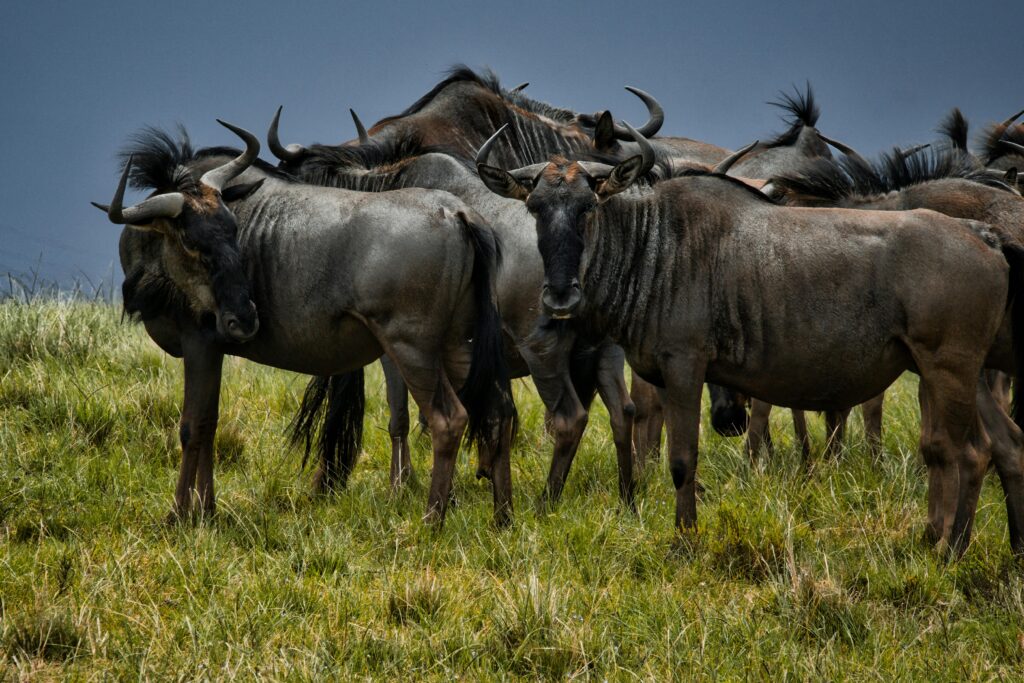A new study, published by Joseph Ogutu, a Senior Researcher and Statistician at the University of Hohenheim and his team, highlights the growing concern about the genetic weakening of wildebeest populations that are unable to migrate.
Migration is crucial for wildebeest survival as it supports their genetic diversity through random mating across wide areas, avoiding inbreeding. However, human-induced barriers like roads, railways, fences, and urban development are interrupting their migration routes, especially in the Serengeti-Mara ecosystem.
This disruption has led to isolated and inbred populations that are genetically weaker, with reduced fertility and lower resilience to diseases and environmental changes.
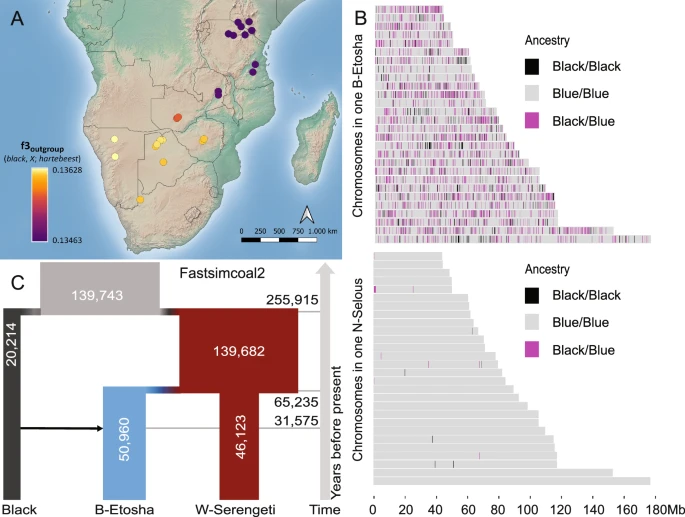
Ogutu’s research, which examined 143 wildebeest across Africa, found that non-migratory populations exhibited less genetic diversity, making them more vulnerable to extinction.
The study underscores the critical role migration plays not just for wildebeest but for entire ecosystems, as their movement helps maintain vegetation and supports other species. Additionally, the collapse of migrations poses risks to wildlife tourism, a significant source of revenue in Kenya and Tanzania.
A look at Wildebeest Species and their Migratory Behaviours
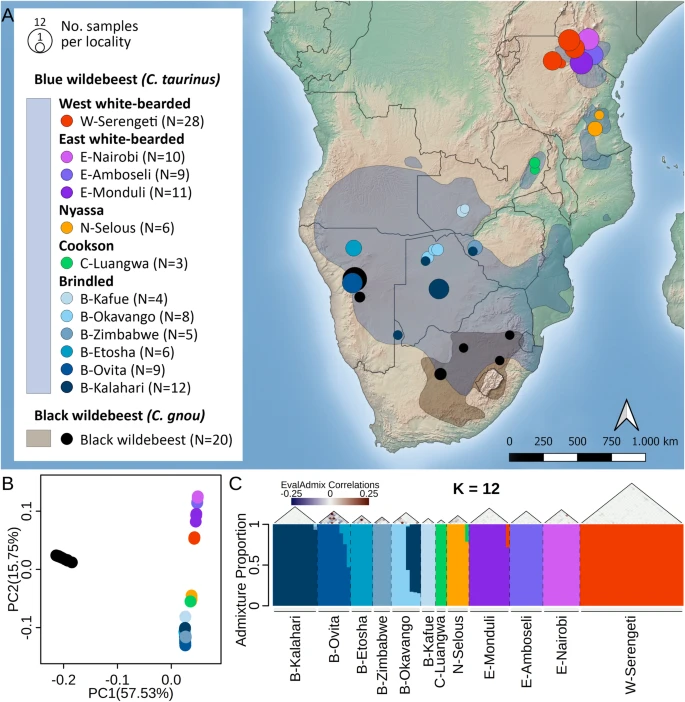
Different Migratory and Non-Migratory Wildebeest Species;
From Ogutu’s study on wildebeest populations, we can distinguish the following wildebeest species, focusing on key details, such as their habitat, physical characteristics, behavior, and population trends. Below are expert details of the different wildebeest species:
1. Blue Wildebeest (Connochaetes taurinus):
- Habitat: Primarily found in open grasslands and woodlands of Southern and Eastern Africa. They are highly migratory in areas like the Serengeti-Mara ecosystem.
- Physical Characteristics: They are larger and more robust, with a dark grey or blue coat, and distinctive dark vertical stripes. They have a prominent beard and curved horns.
- Behavior: Known for their Great Migration in the Serengeti-Mara ecosystem, where around 1.1 million wildebeest migrate annually in search of fresh grazing. This migration covers 1,800 miles and involves crossing rivers where many fall prey to crocodiles.
- Population Trends: The Serengeti-Mara wildebeest population, although still large, has faced declines of 15-20% due to habitat loss, fencing, and human encroachment in surrounding areas.
2. Black Wildebeest (Connochaetes gnou):
- Habitat: Indigenous to South Africa, particularly the highveld plains. They prefer open grassland regions with access to water.
- Physical Characteristics: Black wildebeests are smaller than blue wildebeests, with a dark brown or black coat and a distinctive white tail. They have forward-curved horns.
- Behavior: Unlike the blue wildebeest, black wildebeests are not migratory but show local movements based on resource availability. They are more territorial, forming smaller herds than their migratory counterparts.
- Population Trends: Historically, black wildebeests were nearly hunted to extinction in the 19th and early 20th centuries. Conservation efforts in South Africa have led to a recovery, and their population is now stable, with estimates of 18,000-20,000 individuals.
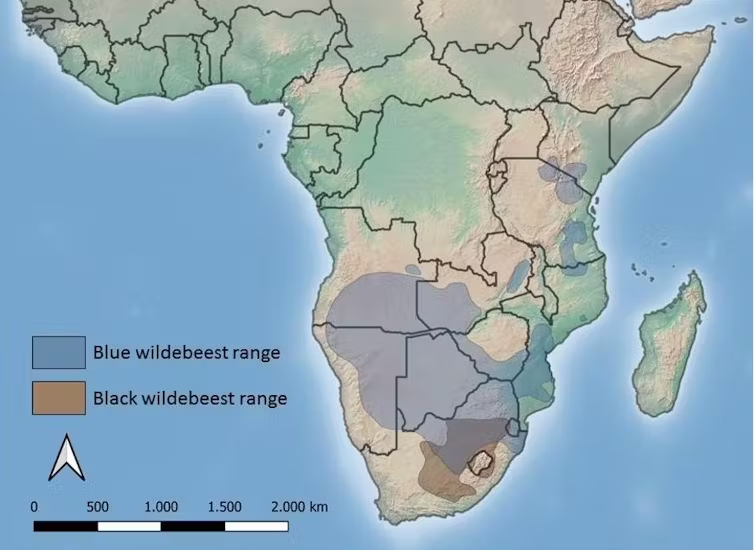
3. Eastern White-Bearded Wildebeest (Connochaetes taurinus albojubatus):
- Habitat: Found in Eastern Africa, primarily in Kenya’s Masai Mara and Tanzania’s Serengeti regions.
- Physical Characteristics: This subspecies of the blue wildebeest is characterized by a white beard on their chin and throat, with a lighter coat compared to other blue wildebeest populations.
- Behavior: Like the larger blue wildebeest population, they participate in the annual migration, contributing to the Great Migration alongside zebra and other herbivores. Their movements follow the seasonal rains to ensure they have access to fresh grass.
- Population Trends: Population declines of 20-30% have been recorded in localized areas such as Kenya’s Masai Mara due to the encroachment of human settlements, fencing, and agricultural expansion. The total population is still robust, but localized threats are increasing.
4. Western White-Bearded Wildebeest (Connochaetes taurinus mearnsi):
- Habitat: Mainly found in parts of Western Tanzania and parts of Eastern Congo, though their range is significantly smaller compared to the eastern counterpart.
- Physical Characteristics: They are similar to the Eastern white-bearded wildebeest but tend to have slightly different markings and can show a bit more variation in their coat color.
- Behavior: Less is known about the movements and specific behaviors of this subspecies as compared to the migratory eastern wildebeest. They tend to be more localized.
- Population Trends: This species is more vulnerable due to habitat fragmentation, disease, and hunting. There are concerns about their genetic diversity and numbers because they are less protected and more localized.
5. Nyasa Wildebeest (Connochaetes taurinus johnstoni):
- Habitat: Found in Southern Tanzania, particularly in the Selous Game Reserve, and parts of Northern Mozambique.
- Physical Characteristics: This species is smaller and darker than the other wildebeest populations and has distinctive markings on its face. The horns of the Nyasa wildebeest are also thinner and less robust than those of the blue wildebeest.
- Behavior: They are less migratory but exhibit seasonal movements based on water and grazing availability. They are often found in smaller herds compared to the large migratory herds of other subspecies.
- Population Trends: The Nyasa wildebeest population is considered stable but vulnerable to poaching, habitat loss, and disease transmission from domestic animals. Conservation efforts are focused on maintaining protected areas like Selous.
6. Cookson’s Wildebeest (Connochaetes taurinus cooksoni):
- Habitat: Primarily located in the Luangwa Valley of Zambia. This subspecies has one of the smallest geographic ranges.
- Physical Characteristics: Smaller than most other wildebeests, Cookson’s wildebeest has a lighter coat with less prominent stripes, and shorter horns.
- Behavior: They are non-migratory, and their herds tend to remain within the Luangwa Valley. They show less seasonal movement compared to other wildebeest species and subspecies.
- Population Trends: Cookson’s wildebeest is one of the most endangered wildebeest subspecies, with a population estimated at fewer than 4,000 individuals. The species is highly threatened by poaching and habitat destruction due to human settlement and farming in the Luangwa Valley.
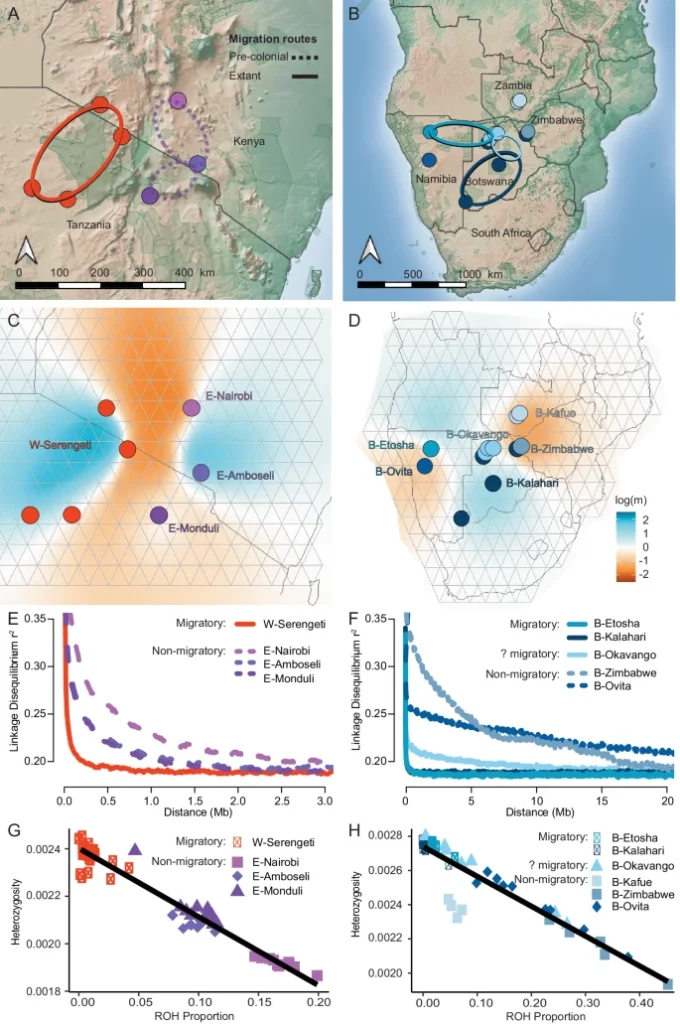
Summary Table:
| Species | Location | Characteristics | Migration/Behavior | Population Trends |
|---|---|---|---|---|
| Blue Wildebeest | Serengeti-Mara, Southern Africa | Dark blue/grey coat, curved horns | Highly migratory | Decline of 15-20% in recent decades |
| Black Wildebeest | South Africa | Dark brown/black coat, forward-curved horns | Non-migratory, territorial | Population now stable after conservation efforts |
| Eastern White-Bearded Wildebeest | Kenya, Tanzania (Serengeti-Mara) | White beard, lighter coat | Participates in Great Migration | Declines of 20-30% in localized areas |
| Western White-Bearded Wildebeest | Western Tanzania, Eastern Congo | Similar to Eastern but with slight color variation | Less migratory, localized | Vulnerable, small range and less protection |
| Nyasa Wildebeest | Southern Tanzania, Northern Mozambique | Smaller, darker, thin horns | Seasonal movements | Stable but vulnerable due to poaching |
| Cookson’s Wildebeest | Zambia (Luangwa Valley) | Lighter coat, shorter horns | Non-migratory | Endangered, fewer than 4,000 individuals |
Migratory vs Non-Migratory Populations
- Healthier DNA in Migratory Populations: Migratory wildebeests that still follow their traditional routes, such as those moving between Kenya’s Masai Mara and Tanzania’s Serengeti, have greater genetic diversity. Their gene pools reflect a wider range of genetic connections, indicating lower inbreeding and more robust genetic health. This diversity is crucial for their resilience against environmental stresses and changing ecosystems.
- Non-Migratory Populations at Risk: Wildebeest populations that no longer migrate, such as certain herds in Botswana and parts of Kenya, exhibit a decline in genetic health. The study concluded that these isolated populations face a higher risk of genetic decline, which could impact their long-term survival.
The study calls for urgent action from policymakers to preserve wildebeest migration routes by protecting arid and semi-arid lands, drought refuges, and strategically regulating land use to prevent further disruption. Efforts should also include reintroducing endangered species and creating zones for wildlife to ensure long-term conservation of these iconic migrations.
Below is a table summarizing the different wildebeest populations mentioned in the study, highlighting key features such as migratory status, genetic diversity, population size, and conservation concerns:
| Population | Migratory Status | Genetic Diversity | Effective Population Size | Conservation Concerns | Key Notes |
|---|---|---|---|---|---|
| Migratory Wildebeest | Migratory | High | Large | Habitat fragmentation and disruption of migration routes | These populations maintain genetic diversity through wide-ranging migrations, ensuring genetic connectivity across different regions. |
| Non-Migratory Wildebeest (isolated populations) | Non-Migratory | Low | Small | High inbreeding rates, genetic erosion due to population isolation | Human-induced barriers such as fences and roads have disrupted their migration, leading to reduced genetic diversity and smaller population sizes. |
| Wildebeest in areas with partially disrupted migration | Semi-Migratory | Moderate | Moderate | Ongoing threats from increasing habitat fragmentation | Populations that still maintain some migratory behavior but are under pressure due to habitat fragmentation, leading to reduced genetic diversity. |
Summary of findings showing weaking of non-migrating wildebeests
The study on wildebeest populations reveals significant findings regarding the non-migrating wildebeest populations, which grow genetically weaker due to several factors. The study shows that non-migratory wildebeest populations exhibit:
- Lower Genetic Diversity: Non-migratory populations show reduced genetic diversity compared to their migratory counterparts. This is evident in their lower heterozygosity levels and a higher presence of runs of homozygosity (ROH), indicating more inbreeding within these groups.
- Increased Inbreeding: The non-migratory populations have higher levels of inbreeding, leading to greater genetic homogeneity. This inbreeding weakens these populations by limiting their evolutionary potential and reducing their ability to adapt to environmental changes.
- Genetic Barriers: EEMS (Estimation of Effective Migration Surfaces) analysis highlights that non-migratory populations face more genetic barriers, which reduce gene flow across regions. This isolation increases their vulnerability and weakens their long-term survival.
These findings suggest that maintaining migration routes is crucial to preserving the genetic health and diversity of wildebeest populations, as non-migratory populations are more prone to genetic erosion.

